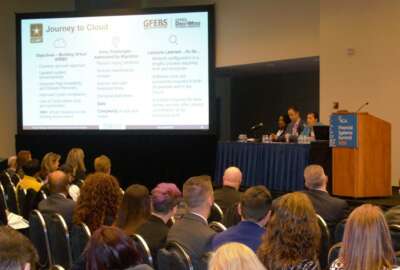Early success spurs Army to expand contract writing system MVP
Bill Hepworth, deputy program executive officer for the Army’s program executive office enterprise information systems (PEO-EIS), said after testing out the new...
The Army’s six-year journey to implement a modern contracting writing system is about to hit a key benchmark.
After testing its minimum viable product with about 100 users at 29 different sites over the summer, the Army plans to triple the number of users in the early part of 2024.
Bill Hepworth, deputy program executive officer for the Army’s program executive office enterprise information systems (PEO-EIS), said this attempt to develop an Army contract writing system will be different than previous efforts, which have fallen well short of expectations.

“We were performing a lot of research to determine how best to get this contract writing solution in the hands of the contracting professionals as quickly as possible. The Air Force contracting IT solution was actually being used very effectively by the Air Force, and as we began having conversations with them, we realized there’s a tremendous amount of synergy between Army contracting and the Air Force’s contracting approach,” Hepworth said on Ask the CIO. “At such a point, we looked at it and said that the actual shortest path is not to continue on the path that we are presently on, but rather to pivot and to use an existing government-off-the-shelf (GOTS) product. That kind of informed our decision to enter into an interagency agreement with the Air Force and also the Department of Agriculture, who was acting as the integrator, and then the Defense Logistics Agency, subsequently, for the hosting. What we really have now is we are leveraging an existing capability via government interagency agreements, which is working out exceptionally well.”
Over the last 15 months, Army PEO-EIS took an agile approach to develop and launch capabilities using the Air Force CON IT as its baseline, which is based on technology from Appian. The Army is using the CON IT as a common core of the contract writing system, and then the Army is conducting business process reengineering efforts to move more toward commercial approaches.
Hepworth said applying an agile development methodology has been a major difference with the move to CON IT and previous attempts.
“The goal behind that was to put it out there, start getting the users experiences and get their feedback so that we can continue to improve the product in a series of small increments in the first quarter of 2024,” he said. “We’re hoping to expand that out to 350 additional users, and then in the six months after that, we will also be expanding out the user scope to about 2,800 users, which will be dependent upon us completing the General Fund Enterprise Business System (GFEBS) interface, which will unlock a whole new set of functionality and features and start making the system is really super compelling at that point.”
The Army had to shift to the Air Force CON IT system after pulling the plug on its contract with CGI in 2022. The Army hired CGI under a 10-year, $133.9 million contract in June 2017. The program struggled for several years, including in 2019 when the Army issued a “cure” letter to CGI.
In addition to the Air Force, several agencies in the Fourth Estate also are using the CON IT contract writing system.
The Navy, which also struggled under its contract with CGI to develop a contract writing system, released a request for information for a new path in August for something called the “core contracting module.”
Measures of Army’s success
Hepworth said despite the challenges with the CGI led project, PEO-EIS learned a great deal from that experience.
“I would say we’re able to take advantage of an awful lot. So one of the most expensive parts of building a system really doesn’t always come from the IT side frequently, it comes from the business process reengineering efforts, the requirements definition, and starting to figure out your data taxonomies. It also includes starting the service level agreements (SLA) process with your data partners,” he said. “We were able to leverage pretty much all of that. There was heavy usage from what came before, and I think the PEO really does not take it lightly ever to have to pivot. Once we get a plan down, we like to execute that plan. However, we hold ourselves to a very high standard in terms of delivering capabilities, and our obligation is to our functionals to make sure that we get them the products they’re asking for at the fastest possible delivery cadence we can. So that ultimately, I think, was the tipping factor to pivoting to the Air Force system.”
Hepworth said the measures of success of the new contract writing system are mainly focused on user adoption and experience.
The goal is for contracting officers and other acquisition workers to drive changes to current capabilities and push for new ones.
PEO-EIS conducts studies and collects feedback about how the latest module is performing or capabilities is meeting the user’s needs. Hepworth the user experience focus is a key factor in the move to iterative or agile development.
“Our long term vision is we would like to have around 10,000 of the Army contracting professionals using the system and I think that incorporates compasses some 300 sites. We would like a CWS to be the contract writing solution, bar none across the Army,” he said. “The key tenant of agile is you’re responding to change, it’s designed to handle change. So we do expect there may be priority changes, there may be features that are required faster than others that we’re planning today. So I will only say that it will be conditions based and once the product is ready for full rollout, then it will go. But we do hope it’s over the next couple of years, and we do envision you will see a steady cadence of releases with ever increasing populations. We are very keen and anxious to retire the three legacy systems that support it today. So for us moving that date left is always an objective.”
Hepworth declined to give a specific date or timeline for when the Army would complete the initial roll out of the entire contract writing system.
Shutdown legacy systems
Part of how PEO-EIS will shut down the three legacy systems is through the “strangler” pattern of development, meaning as new capabilities replace old ones, those old ones will be turned off.
“ACWS will increasingly stand up and take over the role for numerous capabilities of the system before we ultimately retire that system out. But at no point in time, will we have both systems receiving data entry,” Hepworth said. “Now in certain cases where it might be necessary for a period of time to populate data from a new system into the old system for continuity purposes. We are already investigating using things like artificial intelligence and robotic process automation to help us to that. We have numerous strategies already in place to help us deal with the evolution to the new target platform.”
The use of agile development for the contract writing system is one of several programs that will initiate a significant shift in PEO-EIS.
Hepworth said the shift to agile from waterfall techniques is a major priority in 2024.
“Every one of our programs now is investing in training their staff on the Scaled Agile Framework, which is our default agile framework for agile program management. Within that, we are leaning on our technology service providers to come to bear with highly trained, skilled, agile staffing,” he said. “This organization has already changed significantly in the terminologies we use, our style is more adaptive and designed to decompose large problems and solve all the small ones on a consistent basis. At the same time, the digital transformation itself has been nothing short of phenomenal that we are no longer just redefining business processes, putting on a piece of paper and saying go build, we really are now bringing the system integrators in to help solve the business process problems, and to help guide us using technology to improve all of our business processes, which is kind of like the Holy Grail of digital transformation.”
Copyright © 2025 Federal News Network. All rights reserved. This website is not intended for users located within the European Economic Area.
Jason Miller is executive editor of Federal News Network and directs news coverage on the people, policy and programs of the federal government.
Follow @jmillerWFED








